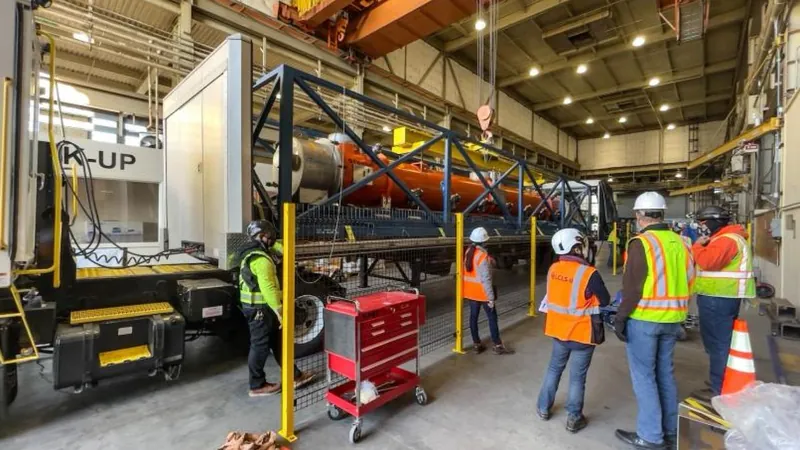
Upgraded X-ray Laser Set to Revolutionize our Understanding of the Atomic World
2024-10-09
Author: Jia
Exciting advancements are on the horizon for the scientific community as plans unfold for a colossal upgrade to the Linac Coherent Light Source (LCLS)—the most powerful X-ray laser globally. This substantial boost comes courtesy of the U.S. Department of Energy (DOE) and will be executed at the SLAC National Accelerator Laboratory, nestled just beside Stanford University in the vibrant San Francisco Bay Area.
The LCLS has been pivotal in revealing the microscopic building blocks of our universe by firing intense X-ray beams at atoms, nanostructures, and molecules. This innovative technique enables researchers to examine the atomic processes that underpin various natural phenomena, particularly in the realms of quantum mechanics, energy studies, and biological sciences.
What sets free-electron lasers, like the LCLS, apart is their ability to generate an exceptionally wide spectrum of brilliant light. Unlike conventional lasers, the LCLS accelerates electrons to near-light speeds and harnesses them through a series of undulators—arrayed magnets that coax electrons to emit concentrated bursts of photons. This process yields supercharged X-ray imaging, illuminating particles with remarkable clarity.
A Historic Upgrade Journey
The LCLS operates within a two-mile (3.2-kilometer) tunnel that was initially established for a particle accelerator back in 1962. The first significant upgrade occurred in 2023 with the "LCLS-II" initiative, dramatically increasing the brightness of the laser beam. Remarkably, the upgraded LCLS-II is now one trillion times more intense than standard hospital X-rays, producing bursts of up to a million pulses per second—each pulse lasting mere femtoseconds, or roughly the distance light travels in 300 nanometers, roughly the size of a virus.
Utilizing this astonishing capability, researchers captured groundbreaking real-time imagery of chemical processes—one highlight being the first observation of chemical bond formation in 2015, followed by the dynamics of photosynthesis in 2023, offering vital insights into energy conservation in new solar technologies.
The LCLS-II-HE Upgrade: A New Frontier
The latest enhancements, termed LCLS-II-HE, promise to further double the energy output of LCLS-II's electron beam, yielding an astounding overall brightness increase of 3,000 times. More cryogenic modules will be deployed to support this expansion, pushing scientific boundaries even further.
In a collaborative effort, the SLAC National Accelerator Laboratory will join forces with notable institutions including Fermi National Accelerator Laboratory, Michigan State University's Facility for Rare Isotope Beams, and the Thomas Jefferson National Accelerator Facility. Together, they’ll adapt the sophisticated undulator systems designed by the Lawrence Berkeley National Laboratory to meet the heightened output demands of the upgraded facility.
As LCLS Director Mike Dunne put it, "The LCLS-II-HE upgrade will be a transformative advance for the scientific mission of DOE Basic Energy Sciences and the broader scientific community." He likened the previous upgrades to enhancing a movie camera's clarity—this upcoming improvement will dramatically boost the resolution and sensitivity, allowing scientists to visualize atomic-scale movements within materials, chemical processes, and biological structures—tackling some of the pressing challenges of our time.
With an investment of $716 million, the upgrade is anticipated to enhance the research capabilities at SLAC National Accelerator Laboratory, with an expected completion target set for 2030. However, researchers are eager to conduct trials sooner to showcase the laser's enhanced potential.
X-ray lasers, such as LCLS, represent a leap into the future of scientific exploration. They are already proving invaluable in researching optimal designs for nanotechnology and nanomaterials, with applications that could drive innovations in renewable energy technologies and enhance battery efficiency. Scientists hope to uncover intricate details of nanoscale biological processes to pave the way for improved pharmaceuticals.
Stay tuned as this groundbreaking upgrade could redefine our comprehension of the atomic world and unlock a treasure trove of discoveries!

 Brasil (PT)
Brasil (PT)
 Canada (EN)
Canada (EN)
 Chile (ES)
Chile (ES)
 España (ES)
España (ES)
 France (FR)
France (FR)
 Hong Kong (EN)
Hong Kong (EN)
 Italia (IT)
Italia (IT)
 日本 (JA)
日本 (JA)
 Magyarország (HU)
Magyarország (HU)
 Norge (NO)
Norge (NO)
 Polska (PL)
Polska (PL)
 Schweiz (DE)
Schweiz (DE)
 Singapore (EN)
Singapore (EN)
 Sverige (SV)
Sverige (SV)
 Suomi (FI)
Suomi (FI)
 Türkiye (TR)
Türkiye (TR)